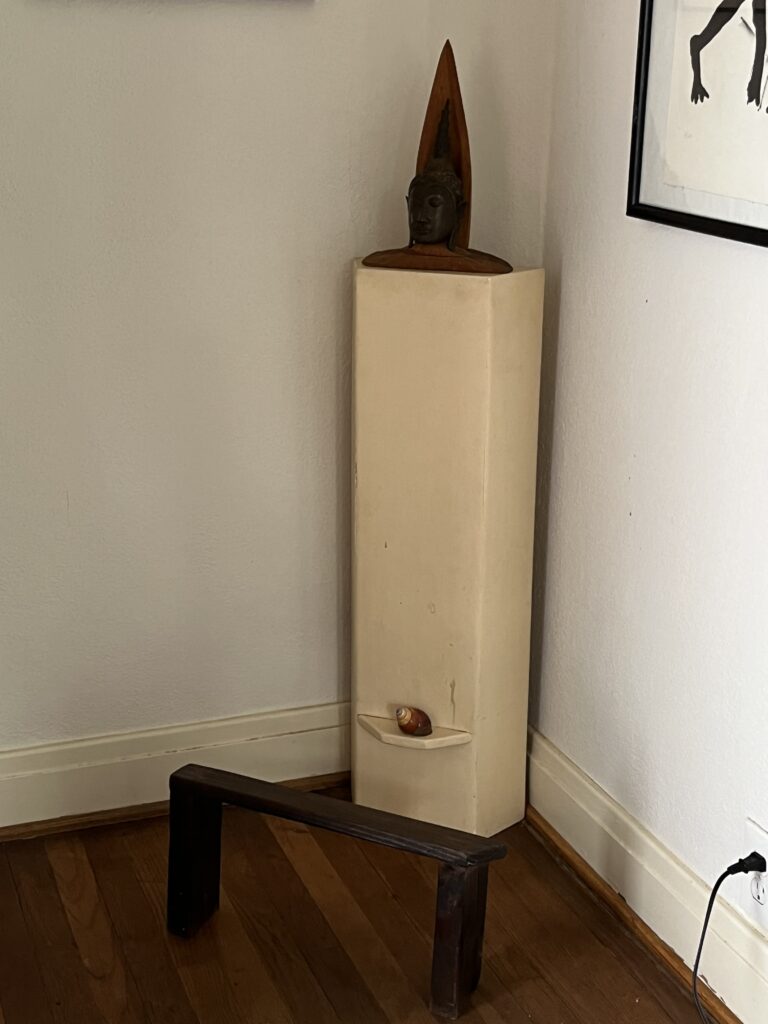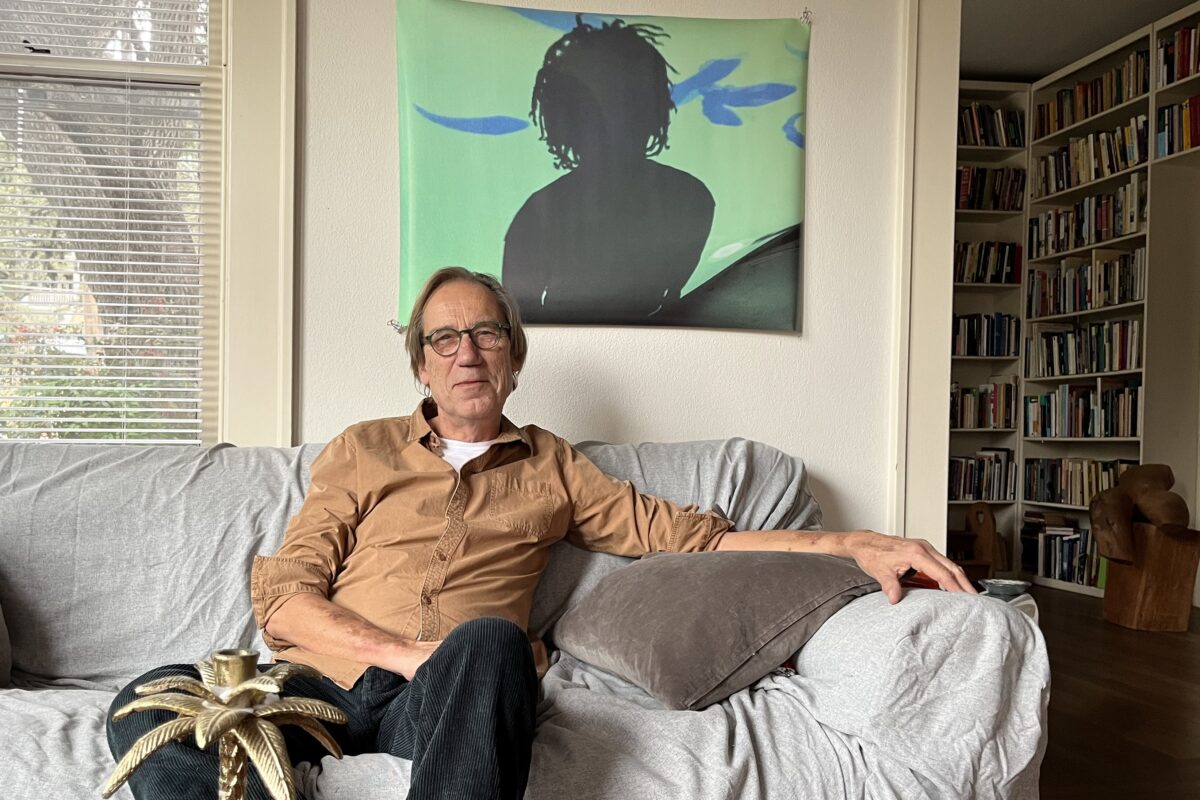Jürgen Streeck on linguistics, hip-hop, and car mechanics
“A child is born with no state of mind,
– Grandmaster Flash and the Furious Five
Blind to the ways of mankind.”
Sitting at a table he made himself and sipping an afternoon coffee, his contented cat asleep in the next room, professor Jürgen Streeck describes his life in academia as one on the margins of several disciplines. He has a Ph.D. in linguistics, teaches communication studies, and holds appointments in anthropology and Germanic studies in UT’s College of Liberal Arts. His work, which focuses on the movement and methods of the human body in communication, doesn’t fall neatly into any one discipline but is at the center of the burgeoning field of “embodied interaction” or “multimodal communication.”
A pioneer in the study of embodied human interaction and the cultural foundations of communication, Streeck studies how people use their hands, bodies, gestures, and gazes when they interact with each other and how that all shapes the ways communities and societies develop. At the heart of his inquiries is the question of what makes us human. For Streeck, part of the answer lies in the use of, and making things with, our hands.
Streeck and his fields of linguistics and anthropology understand the human species as one that makes symbols and that communicates through these symbols. In this view we essentially form our minds and selves, and in turn our communities, through our bodies’ interactions with each other and the world, and those interactions often start with our hands. Consider the way we first learn about the world as babies by grabbing things and how our hands can perform increasingly complex movements as our brains develop. But to truly understand the importance of our hands, we have to rewind back — way back — to when primates developed opposable thumbs.
“Acquiring opposable thumbs is perhaps the single most important evolutionary change on the road to humanity,” says Streeck. The position of the thumb allowed grasp, and grasp allowed tool making. As tool making became more complex, language began to develop. Prehistoric humans gradually required more collaboration to make things and to communicate about what was out in the world, which in turn required more complex communication methods. First there were gestures and simple verbal calls, then there were words. Brain evolution followed hand evolution. Streeck notes that even our vocabulary reflects this idea, noting that the word “grasp” can mean both to hold and to understand.
In his 2009 book Gesturecraft: the Manu-facture of Meaning, Streeck writes that “gestures are made by the organs that give us our world: hands are not only organs of action and expression, but also of cognition and knowledge acquisition; much of our acquaintance with the world comes from the action and perception of our hands.” The information we take in from physical interaction with the world helps us understand who we are, and there is a whole body of research — spanning from linguistics to neuroscience to art theory — that indicates that the haptic system, or the information we acquire through touch, quite literally helps us wire our brains.
I came to these readings personally as a woodworker. In my own experience, while woodworking projects are often performed alone by a single person, the process of designing and making something out of wood is far from solitary and necessitates multiple interactions with multiple kinds of people — the lumber supplier, the clients, the friends and family you casually discuss your work with, and the other woodworkers you consult with about specific problems that come up. As you do your work, these conversations inform the way you make things and the way you understand the process of making something, and vice versa.
It’s from these experiences that Streeck’s work first struck me: He connects our making of things and our making of meaning. And in his work, he references these kinds of tacit experiences from his own childhood.
“I have always liked making things,” he says. As a child, Streeck made model ships (his grandfathers were sailors), and he gave handmade gifts for Christmas. As an adult, he has filled his Travis Heights home with furniture he made. He shows me the coffee table he fashioned from reclaimed lumber, a shelf holding a collection of small knickknacks and curiosities, and a kind of kneeler he made for a Buddha statue in his home’s entryway. The complexity of his own handwork following the development of his scholarship.



Just as humans made more complex tools and from there developed languages of gesture and then words, so Streeck’s interest evolved toward how the hands are used to communicate. “Eventually I became interested in hand gestures,” he says, “and that made my career.”
Streeck explains that while gestures and symbols are universal in human interaction, specific gestures and symbols are not. Linguists have actually found that there are no universals of language at all, he says. What they have found is that there are universals of language change. No matter what its specific structure is, the grammar of any given language begins when words that have concrete meaning take on more abstract generalized functions.
In the almost law-like way in which languages develop, nouns and verbs come first, then adjectives followed by grammatical changes like tense. Most linguists also agree that language started with indexical forms of communication, like pointing at things in the world. “Then people began to go hunting,” says Streeck, “and they had to come home and report what happened, and that required a different kind of symbolization like pantomime.”
What this all means, according to Streeck, is that language conceptualizes experience. We start with a body in the world, and then we have to communicate with each other about it. From there, we are able to form our communities and cultures; then communities continue to shape their languages. One begets the other, and so forth. “By every act of speaking, we change language,” he says.
One of the best modern examples of both language evolution and the way language forms community can be found in hip-hop music, which Streeck avidly follows and teaches a course on.
“Hip-hop has become a kind of global language that most of the world has embraced,” he says. “I try to teach hip-hop as a metaphor for how language has become global but also adapts to local needs. If we look at how hip-hop developed, we can see how rappers discovered one thing after another about language. It began with end rhymes, then got more complex. Rappers discovered that bigger words of Latin origin enabled multi-syllable rhymes, and they discovered metaphor, allegory — layer after layer of language — and use it creatively. And making sense of it and reconstructing it allows listeners to learn in a poetic way about how language evolves and disseminates.”
Consider Run DMC’s classic 1983 song “It’s Like That”
Unemployment at a record high
People coming, people going, people born to die
Don’t ask me because I don’t know why
But it’s like that and that’s the way it is
compared with Wu Tang’s classic “Cream” 10 years later, which has more complex rhyme schemes, incorporates regional and local idioms, and uses more evocative, complex beats:
I grew up on the crime side, the New York Times side
Stayin’ alive was no jive
Had secondhands, Mom’s bounced on old man
So then we moved to Shaolin land
A young youth, yo, rockin’ the gold tooth, ‘Lo goose
Only way I begin the G off was drug loot
And let’s start it like this, son
Rollin’ with this one and that one, pullin’ out gats for fun
But it was just a dream for the teen
Who was a fiend, started smokin’ woolies at 16
And runnin’ up in gates and doin’ hits for high stakes
Makin’ my way on fire escapes
And, by the end of the ‘90s, Latin and Caribbean influences can be heard in the music of Big Pun, Busta Rhymes, Pharrell and the Neptunes, and more.
Streeck’s interest in hip-hop began in the genre’s nascence the same way many young people’s interests begin: with a girlfriend, in Streeck’s case a Black woman who taught him to dance to Black music. “This was the time of Funkadelic and Disco and she taught me syncopation,” he says. The European culture he grew up in didn’t hear music with the same nuance: “Poor Tina Turner,” he says. “She was very popular in Germany and all the Germans would clap on the wrong beat at her concerts.”
Streeck remembers dancing in a club in Berlin and hearing the just-released “The Message,” a now-classic rap song by Grandmaster Flash and the Furious Five (“It’s like a jungle sometimes it makes me wonder how I keep form going under….”). The idea that you could dance to spoken language was automatically interesting to him. He also just loved the music.
Now Streeck is interested in hip-hop for even more personal reasons. He has a Black daughter — now an assistant school superintendent — who grew up in hip-hop and rap culture in Compton, and a son — now a journalist — who grew up rapping. “Hip-hop has become a way that my family connects, which has contributed to my further emotional attachment to it,” he says.
Most of Streeck’s career and research have emerged from personal or everyday life experience, actually. Take his 2017 book, Self-Making Man: A Day of Action, Life, and Language, which examines the physical action and language of the owner of a local auto-repair shop over the course of one workday. Streeck chose to follow this particular mechanic rather than any other hand-worker because he was already part of his life; he works on Streeck’s car. And considering the necessity in an automotive shop both for hand-tool use and verbal communication about it — diagnosing, fixing, training, etc. — Streeck’s interest made sense. Here was a living example of how the use of the hand begets some sort of culture of communication. And, to boot, the shop owner just seemed like a good guy. “Hussein is a very charismatic person,” Streeck says. “We had a book party at his shop and his customers bought all the copies of my book that I brought to the party.”
With his career-long focus on the experience of the body as an implement for creating language, Streeck can only speculate about the future of human interaction. But even as more and more forms of digital communication take the place of embodied interaction — a thumbs-up emoji is not the same as an actual thumbs up — Streeck intends to continue blazing a trail through what he calls his “last frontier”: touch, one of the least studied and understood modes of communication, albeit another one that begins with our hands.
After scheduling a conference on touch which the pandemic then made impossible, Streeck shifted to make the conference about the pandemic. Participants considered questions on the experience of touch by nurses through layers of protective gear and on the impact of the loss of touch between friends and family during lockdown.
Serendipitously, Streeck also adopted his cat Jazzy during Covid, and credits her with giving him insight into human-animal communication through touch.
“She gets me to come outside so she can sit on my lap out there,” he says. “I’m presently writing about how we built a relationship centered on touch. This is a more basic connection. We get into a state of emotional equilibrium just sitting together.”
This essay was originally published on Extra Credit, COLA’s Substack newsletter. Learn more about Extra Credit and subscribe here.
